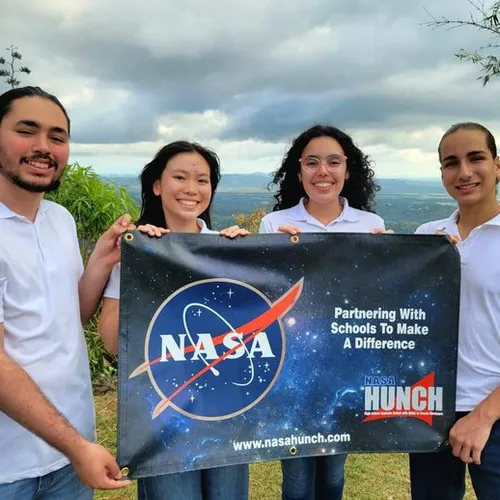Puerto Rico and US VI - FDR
In a momentous event that showcased the ingenuity and perseverance of young minds, students from CROEM's Applied Physics Electronics and Robotics course participated in the Final Design Review with NASA's High School United with NASA to Create Hardware (HUNCH) program. This initiative provided a platform for high school students to collaborate with NASA to develop innovative engineering and software solutions.
After months of rigorous development and testing, the selected students—Diego Roura, Sarah Lu, Miguel González, and Karina Miranda—demonstrated their prototypes, each reflecting a commitment to addressing real-world challenges faced by astronauts. Their hard work culminated in an impressive presentation at the NASA Johnson Space Center in Houston, Texas, where they had the unique opportunity to showcase their projects to esteemed NASA engineers and astronauts.
Diego, Sarah, and Miguel focused on a groundbreaking software prototype designed to enhance astronaut safety by implementing facial recognition technology. This innovative tool aims to identify astronauts who may be at risk of experiencing anxiety attacks during their missions, enabling timely intervention and support. Their project not only highlights the intersection of technology and mental health but also underscores the importance of well-being in extreme environments.
On the other hand, Karina showcased her flagship prototype, which ingeniously combines infrared technology and Braille. This device is specifically tailored to assist disabled staff members within the space environment, ensuring inclusivity and accessibility for all personnel involved in space missions. Her work exemplifies how engineering can empower individuals and enhance the functionality of space operations.
The trip, which took place on April 16th and 17th, marked a significant achievement for these talented students and served as a testament to their dedication and innovative spirit. Their success in the HUNCH program not only reflects their individual talents but also highlights the importance of education in STEM fields, inspiring future generations to pursue careers in science and technology.
As the CROEM community celebrates the accomplishments of Diego, Sarah, Miguel, and Karina, their journey stands as a powerful reminder of what can be achieved through hard work, creativity, and collaboration with organizations like NASA. We extend our heartfelt congratulations to the entire team for their exceptional work and wish them continued success in their future endeavors.

